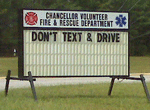The dangers of texting while driving are now widely recognized. Two years ago, a study by the Virginia Tech Transportation Institute (VTTI) indicated that text messaging while driving a truck makes the risk of a crash or near crash event 23.2 times as high as when not texting. This finding helped spur the U.S. government to ban its employees from texting while driving, as well as to ban truck and bus drivers from doing the same. After investigating a fatal truck crash in Kentucky that killed 11 people last year, the U.S. National Transportation Safety Board (NTSB) even recently called for banning the use of cellphones, hand-held or not, by all commercial drivers.
However, even as the dangers of texting (and using cellphones) while driving are known, the knowledge hasn't necessarily changed everyone's behavior.
The AAA Foundation for Traffic Safety recently publicized (PDF) the results of its 2011 Traffic Safety Culture Index which indicated that even while:
"...87 percent of drivers expressed support for having a law against reading, typing, or sending a text message or email while driving...[and] 95 percent of drivers view texting or emailing by other drivers as a serious threat to their own personal safety...35 percent of those same drivers also admitted to having read or sent a text message or email in the previous month."
As of today, 34 states and the District of Columbia have passed a law against texting while driving. Given the latest research by Texas A&M University, the remaining 16 may soon decide to follow.
According to a story appearing in Reuters, researchers at Texas A&M University's Texas Transportation Institute (TTI) have found in that generally speaking, "texting while driving doubles a driver's reaction time."
The TTI researchers tested 42 drivers between the ages of 16 and 54 and had them drive an 11-mile (18-km) test track course while they had to send and receive text messages. They then drove the course without the text messaging distraction. In addition, the drivers were asked to stop when they saw a flashing yellow light.
According to their analysis, the researchers found that drivers were able to respond to the yellow light in 2 seconds or less when not texting, but it took 3 to 4 seconds when they were involved in texting. Furthermore, a "...texting motorist was 11 times more likely to miss the flashing light altogether."
The reaction times did not seem to vary whether the study subject was sending or receiving a text.
The key aspect of the Texas A&M study was that it involved subjects actually driving, instead of being tested in a simulator. While the doubling of reaction time has been seen in simulator studies, the reaction times were much shorter. In other words, in the simulator, nondistracted drivers reacted to an event in less than a second while distracted drivers took about 2 seconds. Traveling at 60 miles per hour, taking 2 seconds to respond means 176 feet, while it's 352 feet for 4 seconds—greater than the length of a football field or many pitches.
The test subjects were told to drive the course—which was wide and flat, with no hills or traffic to contend with—at 30 mph, and even then there were a number of close calls with distracted drivers swerving out of their lanes to the point of hitting safety barrels.
You can watch a TTI video about the study here.
Robert N. Charette is a Contributing Editor to IEEE Spectrum and an acknowledged international authority on information technology and systems risk management. A self-described “risk ecologist,” he is interested in the intersections of business, political, technological, and societal risks. Charette is an award-winning author of multiple books and numerous articles on the subjects of risk management, project and program management, innovation, and entrepreneurship. A Life Senior Member of the IEEE, Charette was a recipient of the IEEE Computer Society’s Golden Core Award in 2008.



